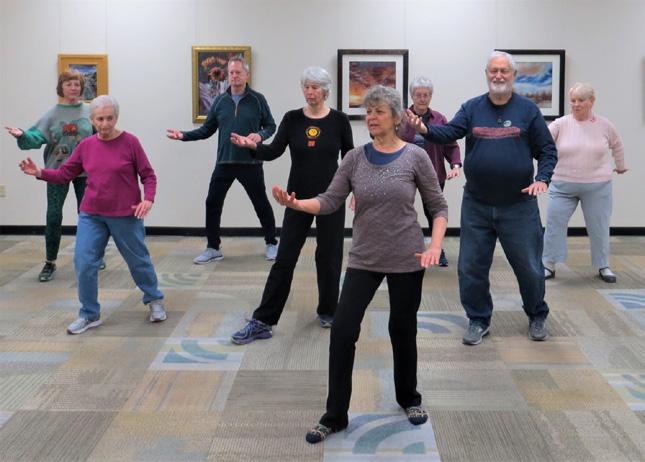PRIME TIME
10 March 2020
Saints In The Wilderness By Shannon Wagers
N
ew Mexico rightfully prides itself on being a land of many cultures. But one group that often gets overlooked in the tourist literature are the Mormon pioneers who figured prominently in the settlement of our western borderlands. From its founding in 1830, the Church of Jesus Christ of Latterday Saints—better known as the LDS Church or the Mormons— had been the target of persecution as a result of its unorthodox
Family Caregivers, FREE Support! Do you provide care for a loved one with a chronic illness? Program focuses on education, support, problem-solving skills, and stress management for family caregivers of people with a chronic illness. Ongoing, 9-week, 90-minute, FREE classes.
Contact Sharon Lewis, RN, PhD, FAAN at 830-377-1484, slewis2@unm.edu
beliefs and practices, particularly polygamy, or “plural marriage,” as it was known. After being forcibly driven out of several eastern states, the Saints, under the leadership of Brigham Young, migrated en masse to Utah’s Salt Lake Valley in 1847. The earliest Latter-day Saints to visit New Mexico were the soldiers of the Mormon Battalion, which was the subject of an earlier column. (Prime Time, May 2017.) But the battalion only passed through on its way to California during the 1847-‘48 Mexican-American War. No permanent Mormon settlements were established here at that time. In the years that followed, the Saints colonized all of Utah and parts of the surrounding territories, and began to proselytize among the native inhabitants. They enjoyed some success at Zuni Pueblo, baptizing a number of converts there, as well as among the neighboring Navajos. So, at the direction of church leaders, a mission was
established nearby in 1876. At first it was called Navajo, but in 1886, it was changed to the biblical name of Ramah (usually pronounced RAY-mah), as it is known today. The town retains its distinctively Mormon character, with broad streets neatly laid out in a grid pattern and lined with stately Lombardy poplars. Ramah Lake, a 50-acre irrigation reservoir just above the town, offers fishing and recreation. At around the same time, other Mormon settlers from the area around Bluff, Utah, were moving into the San Juan country in the northwest corner of New Mexico. Fruitland, Kirtland, Waterflow, and Bloomfield all began as Mormon communities, with Fruitland apparently the center of most church activities. In the 1880s, as the good farmland around the Four Corners was taken up, other settlers ventured south into the valleys of the White Mountains on both side of the ArizonaNew Mexico border, and on into the Gila country, where they founded the villages of Luna, Pleasanton, and Gila. Bluewater, west of Grants, was another early Mormon settlement. These are the communities that have survived. Many others disappeared after a few years, for life was hard in those remote valleys. Disease outbreaks, crop failures, and Apache raids all took their toll. White “gentiles” (the Mormon term for non-Mormons) could be just as dangerous. In the San Juan country, friction with their gentile neighbors led to Mormon fences being cut, cattle stolen,
RECUERDA A CÉSAR CHÁVEZ COMMITTEE 27TH ANNUAL
CÉSAR SATURDAY MARCH 28 CHÁVEZ 2020 DAY
10 am Dedication: Naming of Avenida Dolores Huerta
WITH SPECIAL GUEST
DOLORES HUERTA
10:30 am La Marcha
Begins at the NHCC
(Avenida César Chávez / Avenida Dolores Huerta)
For more information please contact us at:
Featuring Ivón Ulibarrí and The Café Mocha All Star Salsa Band
CesarChavezNM.org rcccabq@gmail.com NATIONAL HISPANIC CULTURAL CENTER 1701 4th Street SW | Albuquerque, NM 87102
Phone: 505-848-3773 101 Hospital Loop N.E., Suite 209, Albuqueruqe, NM 87109 Email: albneuro@albneuro.com
años
N AT I O N A L H I S PA N I C C U LT U R A L C E N T E R
(505) 246-2261 nhccnm.org
But the Mormons repaid them in kind. In 1906, a saloon opened in Fruitland over the vociferous objections of the teetotaling Saints. On Halloween night of that year, a group of masked women wearing Halloween costumes surrounded the saloon and tossed lighted torches against the building, then quickly disbursed. The place went up in flames but the arsonists could not be identified, so no one was ever prosecuted. A second wave of Mormon emigration to New Mexico began around 1911. At that time, some 1,300 Mormons (members of families that had gone to Mexico in the 1880s to escape aggressive enforcement of the U.S. government’s antipolygamy laws) were forced to flee back across the border when the 1910 Mexican Revolution made it unsafe to remain there. Some of the refugees pooled their resources and purchased the little village of Richmond, about 30 miles northwest of Lordsburg. The landowner, the Gila Ranch Co., sold them the site at very favorable terms, and in gratitude they renamed the town Virden, in honor of the company’s president. Many descendants of those families still live in the area. It should be noted that the LDS Church officially ended the practice of plural marriage in 1890, and disavows any connection with the various splinter groups that continue to adhere to it. To my knowledge, no polygamous sects exist in New Mexico.
FREE MEMORY ASSESSMENT
(Avenida César Chávez / Avenida Dolores Huerta) Presented by Las Mujeres
12–3 pm La Fiesta
and irrigation systems wrecked. Occasional gunfire broke out.
Website: www.albneuro.com







